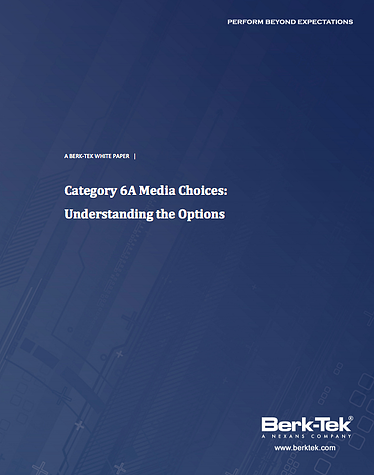The following excerpt from Berk-Tek's white paper: Category 6A Media Choices: Understanding the Options.
Fueled by the popularity of smartphones and tablets, data traffic has been growing at a record pace. According to Cisco, bandwidth requirements are expected to increase three-fold from 2012 to 2017. For business networks, there will be a need to transmit and store 22 exabytes worth of data on a monthly basis by 2017, which is equivalent to saving five and a half billion DVDs worth of information, monthly. To prepare for this staggering need for bandwidth, in 2006, the Institute of Electrical and Electronics Engineers (IEEE) published the standard for 10GBASE-T. Since then, companies that supply every part of this solution have been improving their 10GBASE-T product offerings.
Stepping up to 10G speeds posed many challenges for every network component manufacturer. To achieve ten gigabit transmission rates, technologies for increasing the data rate and improving signal resolution had to be implemented in the 10GBASE-T solution. Initial products and technologies for early 10GBASE-T adopters were not optimized. Physical size, power consumption, and heat generation were all initial technical issues that have now been addressed through multiple technology refinements. These innovations, combined with much lower costs, have made 10GBASE-T an effective solution for today’s network needs.
Given the frequency ranges defined for earlier generations of category cable, one key to optimizing performance lay in managing and mitigating pair-to-pair interference. This issue addressed using both design and manufacturing methodologies, including such factors as physical materials composition, base component quality, conductor concentricity, pair balance, lay-lengths and many others. For CAT 3, CAT 5e and CAT 6 standards, managing internal crosstalk essentially ensured acceptable Signal to Noise Ratio (SNR), and thus acceptable transmissions. To use an analogy, think of a large banquet hall filled with round tables. As long as everyone at the table speaks in moderate voices, everyone at the table is able to have a pleasant evening swapping stories.
The new 10GBASE-T equipment ports available today have the ability to correct for some amount of the channel performance. By using such techniques as digital signal processing (DSP), radio frequency interference (RFI) cancellation and coding algorithms, the factors that contribute to internal SNR can be managed.
In order to achieve 10GBASE-T communications, a much larger frequency range must be employed. With this 5-times greater range (100MHz to 500MHz), the threats to network performance expanded to include not just the noise and interference created within a single cable, but to also now include the noise created by adjacent cables as well. Alien crosstalk (AXT) is this unwanted signal that couples into the channel from sources outside the channel – such as neighboring channels. Alien crosstalk increases when channels are physically close to each other and it is stronger when data transmission uses higher frequencies, and when cables share similar designs, such as multiple pulls of the same cable products. All of these conditions are expected for installations of cabling for 10GBASE-T applications. To return to the banquet analogy, now there are more tables, tightly packed, and the obstacles to good conversation are not limited to balancing the interactions within a single table, but instead also trying to manage to block out and overcome the conversations and noise from adjacent tables.
Unlike noise within a single cable, alien crosstalk is difficult to predict and correct. While systems today can measure and apply correction for single channel performance, there isn’t a controlled method for one device (NIC/port) to measure and account for the output of another device (NIC/port). When enough alien crosstalk couples onto the transmission pairs, link loss and performance issues will occur. Therefore, 10GBASE-T channels must be able to prevent alien crosstalk by minimizing this unwanted coupling.
Minimizing the impact of alien crosstalk between cables is generally achieved in one of two ways;
ensuring adequate spacing between cables or introducing a physical barrier between them. In today’s market, there are three styles of twisted-pair cable that employ various tactics to use space and shielding to ensure that 10GBASE-T networks perform flawlessly. Each option has its own benefits and drawbacks and the selection of which infrastructure is best for a particular project must be based on balancing the competing requirements of cable size, internal electrical performance, alien crosstalk resistance and cost.
This paper provides a comparison of these three available styles, highlighting the application requirements, cable characteristics and technical differences that clarify when one style should be chosen over another.




.png?width=58&height=58&name=X_logo_2023_(white).png)
